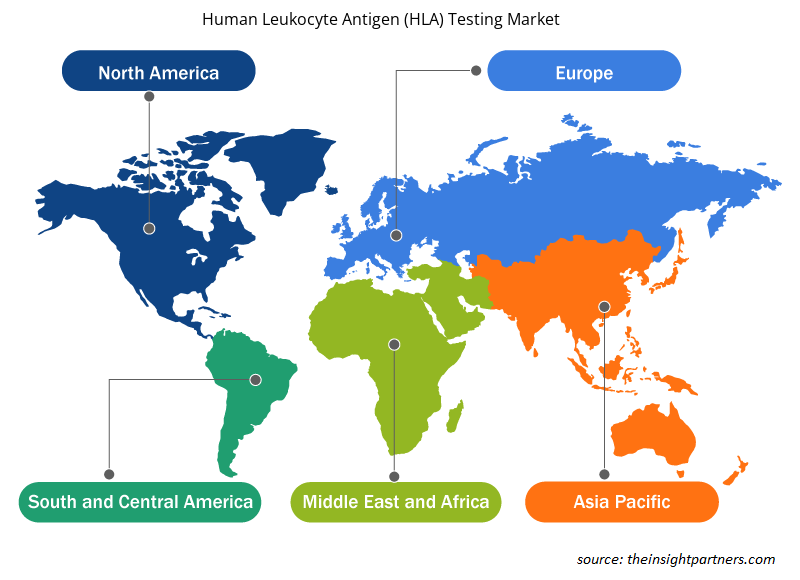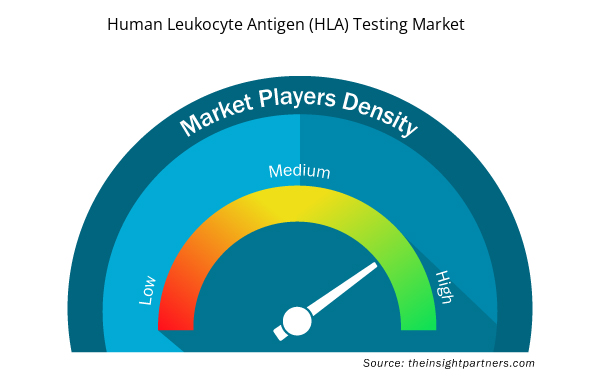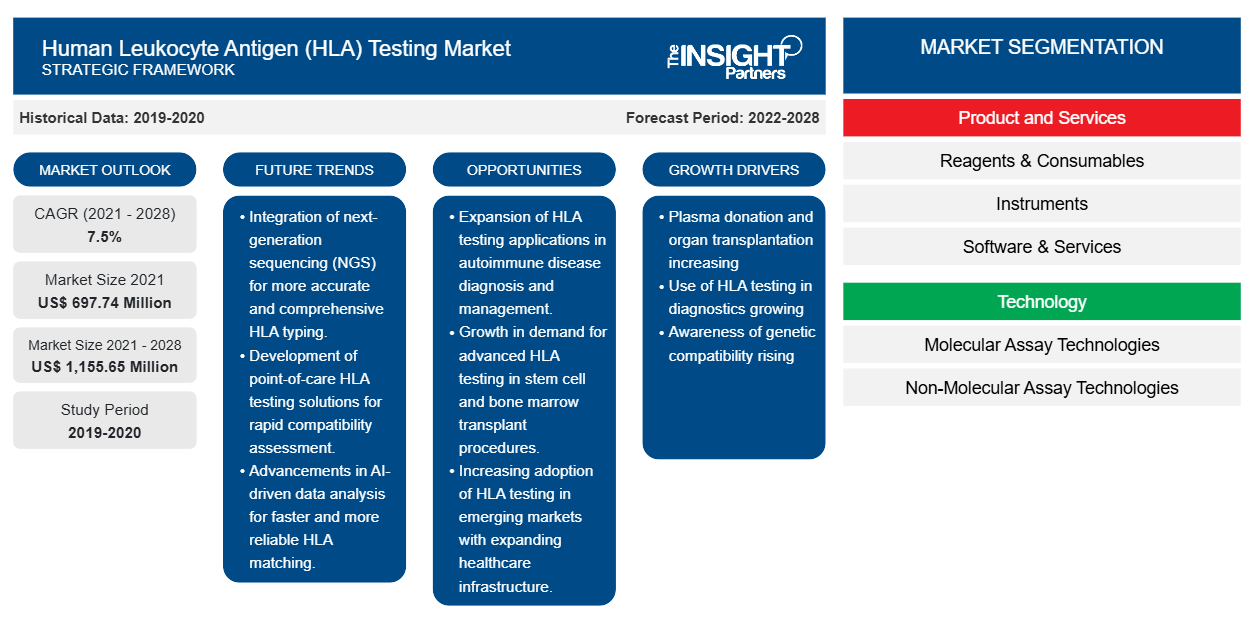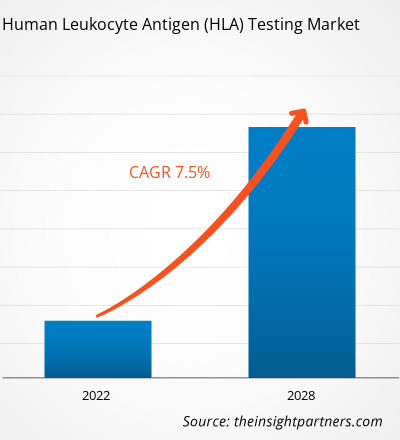Der Markt für Tests auf humanes Leukozytenantigen (HLA) soll von 697,74 Millionen US-Dollar im Jahr 2021 auf 1.155,65 Millionen US-Dollar im Jahr 2028 anwachsen; von 2022 bis 2028 dürfte er eine durchschnittliche jährliche Wachstumsrate von 7,5 % verzeichnen.
Menschliche Leukozytenantigene spielen eine wesentliche Rolle bei der Immunantwort des Körpers auf externe Substanzen. Der Hauptzweck des HLA-Tests besteht darin, Organ- und Gewebetransplantatempfänger mit kompatiblen Spendern zusammenzubringen. Der HLA-Test umfasst auch das Screening von Transplantatempfängern auf das Vorhandensein von Antikörpern, die im Rahmen einer Immunantwort gegen das gespendete Gewebe oder Organ gerichtet sein könnten.
Der Bericht bietet Einblicke und eine eingehende Analyse des Marktes für Tests auf humanes Leukozytenantigen (HLA) und hebt dabei unter anderem Markttrends, technologische Fortschritte und Marktdynamik hervor. Er bietet auch eine Wettbewerbslandschaftsanalyse der weltweit führenden Marktteilnehmer. Darüber hinaus umfasst er die Auswirkungen der COVID-19-Pandemie auf den Markt in allen wichtigen Regionen. Die COVID-19-Pandemie löste weltweit sowohl eine öffentliche Gesundheitskrise als auch eine Wirtschaftskrise aus. Vor der Pandemie wuchs der Markt für Tests auf humanes Leukozytenantigen (HLA) aufgrund der Regelmäßigkeit bei der Beurteilung von Organspendern, Tröstungen und Behandlungen kontinuierlich. Die erste Welle von COVID-19 unterbrach die Konsultationen, Nachuntersuchungen und Screenings im Zusammenhang mit anderen Krankheiten als COVID-19. Mehrere Unternehmen erlitten im letzten Quartal 2019 schwere Verluste; die Pandemie hatte insbesondere im ersten und zweiten Quartal 2020 negative Auswirkungen auf den Weltmarkt. Unternehmen weltweit wurden durch Unterbrechungen der Lieferketten und eine erhöhte Nachfrage nach Gesundheitsprodukten und -dienstleistungen behindert. Um die COVID-19-Infektionen in Krankenhäusern und Kliniken einzudämmen, zogen es Gesundheitsfachkräfte und Patienten vor, ihre Patienten aus der Ferne zu behandeln. Diese unvorhersehbaren Umstände behinderten auch Organtransplantationsverfahren. Viele chirurgische Behandlungen und nicht dringende Konsultationen wurden abgesagt oder verschoben, und in vielen Einrichtungen wurden planmäßige Operationen ausgesetzt, um die Ausbreitung von SARS-CoV-2 einzudämmen sowie Ressourcen zu reservieren und neu zu verteilen, darunter medizinisches Personal (Krankenschwestern und Anästhesisten), medizinische Geräte (persönliche Schutzausrüstung und Beatmungsgeräte) und Betten. Die Empfehlung „zu Hause bleiben“ führte zu einem erheblichen Rückgang der Organspenden und Organtransplantationen. Diese Bedingungen bremsten das Wachstum des Marktes für Tests auf humanes Leukozytenantigen (HLA) weltweit im Jahr 2020.
Passen Sie diesen Bericht Ihren Anforderungen an
Sie erhalten kostenlose Anpassungen an jedem Bericht, einschließlich Teilen dieses Berichts oder einer Analyse auf Länderebene, eines Excel-Datenpakets sowie tolle Angebote und Rabatte für Start-ups und Universitäten.
- Holen Sie sich die wichtigsten Markttrends aus diesem Bericht.Dieses KOSTENLOSE Beispiel umfasst eine Datenanalyse von Markttrends bis hin zu Schätzungen und Prognosen.
Markteinblicke
Steigende Zahl von Plasmaspenden und Organtransplantationen treibt Marktwachstum an
Humane Leukozytenantigene (HLAs) sind spezielle Proteine, die auf allen Zelloberflächen des menschlichen Körpers mit Ausnahme der roten Blutkörperchen vorhanden sind. HLA-Tests finden eine wichtige Anwendung bei Organtransplantationen und werden als Teil der Behandlung von Nierenversagen, chronischer Leberzirrhose und chronischen Herzerkrankungen sowie anderen medizinischen Problemen empfohlen. Die zunehmende Verbreitung chronischer Krankheiten und Organversagens führt zu einer hohen Nachfrage nach Organtransplantationsverfahren und HLA-Tests. Vor der Transplantation wird ein HLA-Test durchgeführt, um die Gewebeverträglichkeit zwischen Patienten und Spendern zu überprüfen und eine Abstoßung des Transplantats zu vermeiden. In den letzten Jahren haben sich Transplantationen weltweit zu einer erfolgreichen Praxis entwickelt. Laut den im Global Observatory on Donation and Transplantation (GODT) veröffentlichten Daten wurden im Jahr 2020 insgesamt 129.681 Organtransplantationen registriert. Davon waren 31,7 % Lebendnierentransplantationen und 20,40 % Lebendlebertransplantationen.
Die Regierungen verschiedener Länder ergreifen Initiativen, um das Bewusstsein für die Notwendigkeit von Organspenden und die Vorteile von Organtransplantationen bei bestimmten Behandlungsverfahren zu schärfen. So hat das Organ Procurement and Transplantation Network (OPTN) einige Strategien umgesetzt, um die Zahl der Organtransplantationen in den USA zu erhöhen. Diese Strategien konzentrieren sich darauf, die Zahl der Organ- und Gewebetransplantationen bei Patienten mit Organerkrankungen im Endstadium zu erhöhen, die aktuelle Organverteilung zu ändern und die Wartelisten für Organtransplantationen durch Umverteilung der bestehenden Organspenden anzupassen. Darüber hinaus hat das OPTN unkonventionelle Strategien zur Verbesserung der Organtransplantation eingesetzt. Zu diesen innovativen Strategien gehören die optimierte Verwendung von Organen verstorbener Patienten (z. B. Spende nach Herztod (DCD) oder hirntoter Spender), die Reduzierung der Organvernichtung, die Förderung von Lebendspenden und die Verbesserung der Rate potenzieller Organspendengenehmigungen.
Somit führt die steigende Nachfrage nach Organtransplantationen zu einem Bedarf an einer größeren Anzahl von HLA-Testkits und Verbrauchsmaterialien, was das Wachstum des HLA-Testmarktes vorantreibt.
Produkt- und servicebasierte Erkenntnisse
Basierend auf Produkten und Dienstleistungen ist der Markt für Tests auf humanes Leukozytenantigen (HLA) in Reagenzien und Verbrauchsmaterialien, Instrumente sowie Software und Dienstleistungen unterteilt. Im Jahr 2021 hielt das Segment Reagenzien und Verbrauchsmaterialien den größten Marktanteil und wird im Prognosezeitraum voraussichtlich die schnellste CAGR von 7,5 % verzeichnen. HLA) testing market is segmented into reagents and consumables, instruments, and software and services. In 2021, the reagents and consumables segment held the largest share of the market, and it is expected to register the fastest CAGR of 7.5% during the forecast period.
Technologiebasierte Erkenntnisse
Basierend auf der Technologie ist der Markt für Tests auf humanes Leukozytenantigen (HLA) in molekulare Testtechnologien und nichtmolekulare Testtechnologien unterteilt. Im Jahr 2021 hielt das Segment der molekularen Testtechnologien den größten Marktanteil und es wird erwartet, dass es im Zeitraum 2022–2028 eine höhere durchschnittliche jährliche Wachstumsrate von 7,7 % verzeichnen wird.HLA) testing market is segmented into molecular assay technologies and non-molecular assay technologies. In 2021, the molecular assay technologies segment held a largest share of the market, and it is expected to record a higher CAGR of 7.7% during 2022–2028.
Endbenutzerbasierte Erkenntnisse
Basierend auf dem Endverbraucher ist der Markt für Tests auf humanes Leukozytenantigen (HLA) in unabhängige Referenzlabore, Krankenhäuser und Transplantationszentren und andere unterteilt. Im Jahr 2021 hielt das Segment der unabhängigen Referenzlabore den größten Marktanteil. Es wird jedoch erwartet, dass das Segment der Krankenhäuser und Transplantationszentren im Zeitraum 2022–2028 die höchste durchschnittliche jährliche Wachstumsrate von 7,9 % verzeichnen wird.HLA) testing market is segmented into independent reference laboratories, hospitals and transplant centers, and others. In 2021, the independent reference laboratories segment held the largest share of the market. However, hospitals and transplant centers segment is expected to report the highest CAGR of 7.9% during 2022–2028
Die Akteure auf dem Markt für Tests auf humanes Leukozytenantigen (HLA) verfolgen organische Strategien wie Produkteinführung und -erweiterung, um ihre Präsenz und ihr Produktportfolio weltweit zu erweitern und gleichzeitig die wachsende Produktnachfrage zu erfüllen.HLA) testing market players adopt organic strategies such as product launch and expansion to expand their footprint and product portfolio worldwide, along with meeting the growing product demands.
Nach Geografie
Geografisch ist der Markt für Tests auf humanes Leukozytenantigen (HLA) segmentiert in Nordamerika (USA, Kanada und Mexiko), Europa (Großbritannien, Deutschland, Frankreich, Italien, Spanien und übriges Europa), Asien-Pazifik (China, Japan, Indien, Australien, Südkorea und übriger Asien-Pazifik-Raum), Naher Osten und Afrika (VAE, Saudi-Arabien, Südafrika und übriger Naher Osten und Afrika) sowie Süd- und Mittelamerika (Brasilien, Argentinien und übriges Süd- und Mittelamerika).
Test auf humane Leukozytenantigen
Regionale Einblicke in den Markt für Tests auf humanes Leukozytenantigen (HLA)
Die regionalen Trends und Faktoren, die den Markt für Tests auf humane Leukozytenantigene (HLA) im Prognosezeitraum beeinflussen, wurden von den Analysten von Insight Partners ausführlich erläutert. In diesem Abschnitt werden auch die Marktsegmente und die Geografie für Tests auf humane Leukozytenantigene (HLA) in Nordamerika, Europa, im asiatisch-pazifischen Raum, im Nahen Osten und Afrika sowie in Süd- und Mittelamerika erörtert.

- Erhalten Sie regionale Daten zum Markt für Tests auf humanem Leukozytenantigen (HLA)
Umfang des Marktberichts zum Testen menschlicher Leukozytenantigenen (HLA)
| Berichtsattribut | Details |
|---|---|
| Marktgröße im Jahr 2021 | 697,74 Millionen US-Dollar |
| Marktgröße bis 2028 | 1.155,65 Millionen US-Dollar |
| Globale CAGR (2021 - 2028) | 7,5 % |
| Historische Daten | 2019-2020 |
| Prognosezeitraum | 2022–2028 |
| Abgedeckte Segmente | Nach Produkten und Dienstleistungen
|
| Abgedeckte Regionen und Länder | Nordamerika
|
| Marktführer und wichtige Unternehmensprofile |
|
Dichte der Marktteilnehmer für Tests auf humanem Leukozytenantigen (HLA): Auswirkungen auf die Geschäftsdynamik
Der Markt für Tests auf humane Leukozytenantigenen (HLA) wächst rasant. Dies wird durch die steigende Nachfrage der Endnutzer aufgrund von Faktoren wie sich entwickelnden Verbraucherpräferenzen, technologischen Fortschritten und einem größeren Bewusstsein für die Vorteile des Produkts vorangetrieben. Mit der steigenden Nachfrage erweitern Unternehmen ihr Angebot, entwickeln Innovationen, um die Bedürfnisse der Verbraucher zu erfüllen, und nutzen neue Trends, was das Marktwachstum weiter ankurbelt.
Die Marktteilnehmerdichte bezieht sich auf die Verteilung der Firmen oder Unternehmen, die in einem bestimmten Markt oder einer bestimmten Branche tätig sind. Sie gibt an, wie viele Wettbewerber (Marktteilnehmer) in einem bestimmten Marktraum im Verhältnis zu seiner Größe oder seinem gesamten Marktwert präsent sind.
Die wichtigsten Unternehmen auf dem Markt für Tests auf humanes Leukozytenantigen (HLA) sind:
- Thermo Fisher Scientific Inc.
- CareDx
- Qiagen
- Illumina Inc.
- Bio-Rad Laboratories, Inc.
Haftungsausschluss : Die oben aufgeführten Unternehmen sind nicht in einer bestimmten Reihenfolge aufgeführt.

- Überblick über die wichtigsten Akteure auf dem Markt für Tests auf humanem Leukozytenantigen (HLA)
Firmenprofile
- Thermo Fisher Scientific Inc.
- CareDx
- Qiagen
- Illumina Inc.
- Bio-Rad Laboratories, Inc.
- TBG Diagnostics Limited
- F.Hoffmann-La Roche Ltd.
- Takara Bio Inc.
- Luminex Corporation
- Omixon Inc.
- Das Sequenzierungszentrum
- Protrans
- HistoGenetics LLC.
- CD Genomik
- Quintara Biosciences
- CeGat GmbH
- Creative Biolabs Inc.
- Historische Analyse (2 Jahre), Basisjahr, Prognose (7 Jahre) mit CAGR
- PEST- und SWOT-Analyse
- Marktgröße Wert/Volumen – Global, Regional, Land
- Branche und Wettbewerbsumfeld
- Excel-Datensatz


- Sports Technology Market
- Artificial Intelligence in Defense Market
- Equipment Rental Software Market
- Asset Integrity Management Market
- Analog-to-Digital Converter Market
- Batter and Breader Premixes Market
- 3D Audio Market
- Green Hydrogen Market
- Fixed-Base Operator Market
- Health Economics and Outcome Research (HEOR) Services Market

Report Coverage
Revenue forecast, Company Analysis, Industry landscape, Growth factors, and Trends

Segment Covered
This text is related
to segments covered.

Regional Scope
North America, Europe, Asia Pacific, Middle East & Africa, South & Central America

Country Scope
This text is related
to country scope.
Häufig gestellte Fragen
Global human leukocyte antigen (HLA) testing market is segmented by region into North America, Europe, Asia Pacific, Middle East & Africa, and South & Central America. In North America, the U.S. is the largest market for human leukocyte antigen (HLA) testing market. The US is estimated to hold the largest share in the human leukocyte antigen (HLA) testing market during the forecast period. The presence of top players and favorable regulations related to product approvals coupled with commercializing new products are the contributing factors for the regional growth. Additionally, the increasing number of technological advancements is the key factor responsible for the Asia-Pacific regional growth for human leukocyte antigen (HLA) testing accounting fastest growth of the region during the coming years.
Thermo Fisher Scientific, Inc., CareDx, Inc., Qiagen N.V., Illumina, Bio-Rad Laboratories, Inc., TGB Diagnostics Ltd., F. Hoffman La-Roche Ltd., Takara Bio, Luminex Corporation, Oximon, The Sequencing Center, Protrans, HistoGenetics LLC, CD Genomics, Quintara Biosciences, CeGaT GmbH, Creative Biolabs, Inc., are among the leading companies operating in the global human leukocyte antigen (HLA) testing market
The molecular assay technologies segment dominated the global human leukocyte antigen (HLA) testing market and is likely to account for the revenue of US$ 626.86 million in 2022.
Human leukocyte antigens play an essential part in the body's immune response to external substances. The principal use for human leukocyte antigen (HLA) testing is to match organ and tissue transplant recipients with compatible donors. HLA testing also involves screening transplant recipients for the presence of antibodies that might target the donated tissue or organ as part of an immune response.
Increasing plasma donation and organ transplants procedures is one of the most significant factors responsible for the overall market growth.
Based on product and service type, reagent and consumables took the forefront leaders in the worldwide market by accounting largest share in 2021 and is expected to continue to do so till the forecast period.
Trends and growth analysis reports related to Life Sciences : READ MORE..
The List of Companies - Human Leukocyte Antigen (HLA) Market
- Thermo Fisher Scientific Inc.
- CareDx
- Qiagen
- Illumina Inc.
- Bio-Rad Laboratories, Inc.
- TBG Diagnostics Limited
- F.Hoffmann-La Roche Ltd.
- Takara Bio Inc.
- Luminex Corporation
- Omixon Inc.
- The Sequencing Center
- Protrans
- HistoGenetics LLC.
- CD Genomics
- Qunitara Biosciences
- CeGat GmbH
- Creative Biolabs Inc.
The Insight Partners performs research in 4 major stages: Data Collection & Secondary Research, Primary Research, Data Analysis and Data Triangulation & Final Review.
- Data Collection and Secondary Research:
As a market research and consulting firm operating from a decade, we have published and advised several client across the globe. First step for any study will start with an assessment of currently available data and insights from existing reports. Further, historical and current market information is collected from Investor Presentations, Annual Reports, SEC Filings, etc., and other information related to company’s performance and market positioning are gathered from Paid Databases (Factiva, Hoovers, and Reuters) and various other publications available in public domain.
Several associations trade associates, technical forums, institutes, societies and organization are accessed to gain technical as well as market related insights through their publications such as research papers, blogs and press releases related to the studies are referred to get cues about the market. Further, white papers, journals, magazines, and other news articles published in last 3 years are scrutinized and analyzed to understand the current market trends.
- Primary Research:
The primarily interview analysis comprise of data obtained from industry participants interview and answers to survey questions gathered by in-house primary team.
For primary research, interviews are conducted with industry experts/CEOs/Marketing Managers/VPs/Subject Matter Experts from both demand and supply side to get a 360-degree view of the market. The primary team conducts several interviews based on the complexity of the markets to understand the various market trends and dynamics which makes research more credible and precise.
A typical research interview fulfils the following functions:
- Provides first-hand information on the market size, market trends, growth trends, competitive landscape, and outlook
- Validates and strengthens in-house secondary research findings
- Develops the analysis team’s expertise and market understanding
Primary research involves email interactions and telephone interviews for each market, category, segment, and sub-segment across geographies. The participants who typically take part in such a process include, but are not limited to:
- Industry participants: VPs, business development managers, market intelligence managers and national sales managers
- Outside experts: Valuation experts, research analysts and key opinion leaders specializing in the electronics and semiconductor industry.
Below is the breakup of our primary respondents by company, designation, and region:

Once we receive the confirmation from primary research sources or primary respondents, we finalize the base year market estimation and forecast the data as per the macroeconomic and microeconomic factors assessed during data collection.
- Data Analysis:
Once data is validated through both secondary as well as primary respondents, we finalize the market estimations by hypothesis formulation and factor analysis at regional and country level.
- Macro-Economic Factor Analysis:
We analyse macroeconomic indicators such the gross domestic product (GDP), increase in the demand for goods and services across industries, technological advancement, regional economic growth, governmental policies, the influence of COVID-19, PEST analysis, and other aspects. This analysis aids in setting benchmarks for various nations/regions and approximating market splits. Additionally, the general trend of the aforementioned components aid in determining the market's development possibilities.
- Country Level Data:
Various factors that are especially aligned to the country are taken into account to determine the market size for a certain area and country, including the presence of vendors, such as headquarters and offices, the country's GDP, demand patterns, and industry growth. To comprehend the market dynamics for the nation, a number of growth variables, inhibitors, application areas, and current market trends are researched. The aforementioned elements aid in determining the country's overall market's growth potential.
- Company Profile:
The “Table of Contents” is formulated by listing and analyzing more than 25 - 30 companies operating in the market ecosystem across geographies. However, we profile only 10 companies as a standard practice in our syndicate reports. These 10 companies comprise leading, emerging, and regional players. Nonetheless, our analysis is not restricted to the 10 listed companies, we also analyze other companies present in the market to develop a holistic view and understand the prevailing trends. The “Company Profiles” section in the report covers key facts, business description, products & services, financial information, SWOT analysis, and key developments. The financial information presented is extracted from the annual reports and official documents of the publicly listed companies. Upon collecting the information for the sections of respective companies, we verify them via various primary sources and then compile the data in respective company profiles. The company level information helps us in deriving the base number as well as in forecasting the market size.
- Developing Base Number:
Aggregation of sales statistics (2020-2022) and macro-economic factor, and other secondary and primary research insights are utilized to arrive at base number and related market shares for 2022. The data gaps are identified in this step and relevant market data is analyzed, collected from paid primary interviews or databases. On finalizing the base year market size, forecasts are developed on the basis of macro-economic, industry and market growth factors and company level analysis.
- Data Triangulation and Final Review:
The market findings and base year market size calculations are validated from supply as well as demand side. Demand side validations are based on macro-economic factor analysis and benchmarks for respective regions and countries. In case of supply side validations, revenues of major companies are estimated (in case not available) based on industry benchmark, approximate number of employees, product portfolio, and primary interviews revenues are gathered. Further revenue from target product/service segment is assessed to avoid overshooting of market statistics. In case of heavy deviations between supply and demand side values, all thes steps are repeated to achieve synchronization.
We follow an iterative model, wherein we share our research findings with Subject Matter Experts (SME’s) and Key Opinion Leaders (KOLs) until consensus view of the market is not formulated – this model negates any drastic deviation in the opinions of experts. Only validated and universally acceptable research findings are quoted in our reports.
We have important check points that we use to validate our research findings – which we call – data triangulation, where we validate the information, we generate from secondary sources with primary interviews and then we re-validate with our internal data bases and Subject matter experts. This comprehensive model enables us to deliver high quality, reliable data in shortest possible time.


 Holen Sie sich ein kostenloses Muster für diesen Bericht
Holen Sie sich ein kostenloses Muster für diesen Bericht